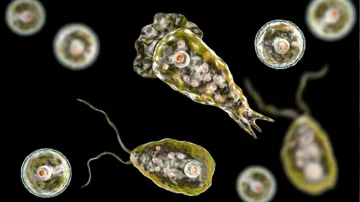A five-year-old girl from Malappuram, Kerala, died of amoebic meningoencephalitis at the Government Medical College Hospital in Kozhikode. The girl, Fadva had been in treatment since May 13. She was on ventilator support for more than a week, and despite the doctor's best efforts, the girl died. Her disease, amoebic meningoencephalitis, was caused by the Naegleria fowleri amoeba, an uncommon but serious brain infection.
What is Brain-Eating Amoeba?
Brain-eating amoeba, scientifically known as Naegleria fowleri, is a rare but deadly organism that can cause a severe brain infection called primary amebic meningoencephalitis (PAM). It is a single-celled amoeba commonly found in warm freshwater environments, such as lakes, rivers, hot springs, and poorly maintained swimming pools. According to Dr. Jatin Ahuja, Senior Consultant, Infectious Disease Specialist, Indraprastha Apollo Hospitals, "Primary Amebic Meningoencephalitis or PAM is an extremely rare but invariably fatal infection of the brain caused by the free-living amebic organism Naegleria fowleri. N. fowleri is a thermophilic ameba found in warm freshwaters like lakes, rivers, hot springs, and unchlorinated swimming pools, especially when water temperatures rise above 85°F (30°C)."
Causes of Brain-Eating Amoeba Infection
Infection occurs when contaminated water containing Naegleria fowleri enters the body through the nose. This can happen while swimming, diving, or even when using contaminated water for activities like nasal irrigation or neti pot use. Once inside the nasal passages, the amoeba travels to the brain, where it causes inflammation and destruction of brain tissue, leading to PAM.
Symptoms of Brain-Eating Amoeba
Dr. Jatin Ahuja, said "The symptoms are common (headache, fever, nausea, and vomiting) as bacterial or viral meningitis at first. However, within 5-7 days, the patient develops altered mental status, increased intracranial pressure, seizures, hallucinations, or in extreme conditions a coma as the amoeba destroys more brain tissue.
Despite antimicrobial treatment, the fatality rate of PAM is quite high with death usually occurring within 10-15 days due to brain herniation, hemorrhage and irreversible raised intracranial pressure leading to coma and organ failure." The symptoms of PAM typically appear one to nine days after exposure to the amoeba.
Prevention Measures of Brain-Eating Amoeba
While brain-eating amoeba infections are rare, several precautions can help reduce the risk:
- Avoidance of Contaminated Water: Do not swim or dive in warm freshwater sources where the amoeba may thrive, especially during the hot summer months.
- Use of Nose Clips: When participating in water-related activities, such as swimming or diving, wearing nose clips can prevent water from entering the nasal passages.
- Proper Water Treatment: Ensure that swimming pools and other water systems are properly maintained and adequately chlorinated to kill any potential amoeba.
- Nasal Irrigation Safety: If using a neti pot or performing nasal irrigation, only use sterile, distilled, or previously boiled water. Avoid using tap water, especially if it's untreated.
- Limiting Nasal Submergence: Try to avoid submerging the head in hot springs, untreated pools, or other bodies of warm freshwater where the amoeba may be present.
Treatment and Prognosis of Brain-Eating Amoeba
Early diagnosis and treatment are crucial for improving the prognosis of PAM. However, the infection progresses rapidly, and despite aggressive treatment, the mortality rate remains high. Treatment typically involves a combination of antimicrobial drugs, supportive care, and interventions to reduce brain swelling.
Brain-eating amoeba infection is a rare but serious condition that requires awareness and preventive measures, particularly when engaging in activities involving warm freshwater. By understanding the causes, symptoms, and prevention methods, individuals can take steps to reduce the risk of infection and protect their health.
ALSO READ: Delhi Heatwave: 5 important dos and don'ts to follow during scorching summers
